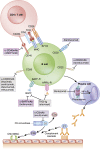Immunosuppressive Medications
- PMID: 26170177
- PMCID: PMC4741049
- DOI: 10.2215/CJN.08570814
Immunosuppressive Medications
Abstract
Immunosuppressive agents are commonly used in the nephrologist's practice in the treatment of autoimmune and immune-mediated diseases and transplantation, and they are investigational in the treatment of AKI and ESRD. Drug development has been rapid over the past decades as mechanisms of the immune response have been better defined both by serendipity (the discovery of agents with immunosuppressive activity that led to greater understanding of the immune response) and through mechanistic study (the study of immune deficiencies and autoimmune diseases and the critical pathways or mutations that contribute to disease). Toxicities of early immunosuppressive agents, such as corticosteroids, azathioprine, and cyclophosphamide, stimulated intense investigation for agents with more specificity and less harmful effects. Because the mechanisms of the immune response were better delineated over the past 30 years, this specialty is now bestowed with a multitude of therapeutic options that have reduced rejection rates and improved graft survival in kidney transplantation, provided alternatives to cytotoxic therapy in immune-mediated diseases, and opened new opportunities for intervention in diseases both common (AKI) and rare (atypical hemolytic syndrome). Rather than summarizing clinical indications and clinical trials for all currently available immunosuppressive medications, the purpose of this review is to place these agents into mechanistic context together with a brief discussion of unique features of development and use that are of interest to the nephrologist.
Keywords: GN; activation; cell; cytokines; immunology; kidney transplantation.
Copyright © 2016 by the American Society of Nephrology.
Figures




References
-
- Calne RY, Alexandre GP, Murray JE: A study of the effects of drugs in prolonging survival of homologous renal transplants in dogs. Ann N Y Acad Sci 99: 743–761, 1962 - PubMed
-
- Murray JE, Merrill JP, Harrison JH, Wilson RE, Dammin GJ: Prolonged survival of human-kidney homografts by immunosuppressive drug therapy. N Engl J Med 268: 1315–1323, 1963 - PubMed
-
- Zukoski CF, Lee HM, Hume DM: The prolongation of functional survival of canine renal homografts by 6-mercaptopurine. Surg Forum 11: 470–472, 1960 - PubMed
-
- Köhler G, Milstein C: Continuous cultures of fused cells secreting antibody of predefined specificity. Nature 256: 495–497, 1975 - PubMed
Publication types
MeSH terms
Substances
LinkOut - more resources
Full Text Sources
Other Literature Sources
Medical
Miscellaneous

